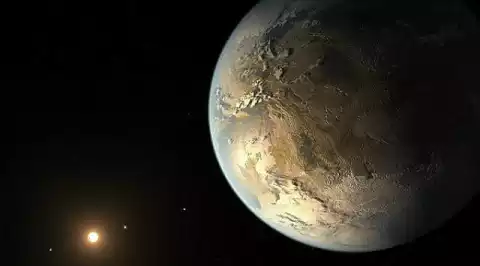
Proxima Centauri is part of the Alpha Centauri astrology system which is about 4.2 light-years from our solar system
In August 2016, astronomers of the European Southern Observatory (ESO) discovered exoplanets (alien planets) close to Earth.
Known, the planet is about four light years from Earth. It orbits in a red star known as Proxima Centauri.
At that time, astronomers believe that the planet called Proxima B can be inhabited by Earth because its mass is 1.3 times heavier than Earth.
At least, their scientific predictions of that time can be trusted. Unfortunately, the prediction was denied by NASA. In his statement, the US space agency confirms if Proxima B is unfit for humans.
"The atmosphere at Proxima B is not what it is on Earth, it could have been destroyed by star radiation, and it is definitely dangerous," NASA quoted as saying on Friday (4/8/2017).
"While the Proxima B orbit is in a habitable zone, it does not mean it can be inhabited, we know that the atmosphere is the most important part that can support human life, but it's different from the planet," he continued.
NASA astronomers prove this statement by using the Earth's atmospheric model, magnetic field and gravity as a sample for Proxima B.
They also calculate how much radiation produced Proxima B on average. The study was conducted at NASA's Chandra X-Ray observatory.
Based on data from the experiments conducted, they can find out how much star radiation affects the atmosphere of Proxima B.
Not only that, another risk that they believe can happen is like extreme ultraviolet radiation that turns out hundreds of times larger than the sun's ultraviolet rays to Earth.
If it refers to the study of ESO astronomers, the so-called climate conditions in Proxima B will be very different from Earth. One of them is caused by the radiation is so strong and the duration of its orbit is only 11 days. As a result, if a person is on the planet, instead of seeing the blue sky, he sees only the red sky.
Although the planet is a short distance from Earth, researchers say the possibility of visiting it is still very far away. There is no spacecraft that can be launched, especially with the existing technology today.
Another problem that has not been solved is the exact location of Proxima B. The researchers say, Proxima B is unlikely to be formed in the current location at this time.
According to an Anglada-Escude researcher, it is likely that the planet was formed elsewhere and got there because it 'migrated'.
I'm going to be blunt in saying this: We have no way to be able to discernibly tell without the use of a probe, the atmospheric conditions of a distant planet. So everything what you've posted above is pure Speculation, Even NASA has said that it's atmosphere "Could" have been destroyed by radiation but not definitely. Nevertheless the point of what I am trying to say is that these press releases are all speculation and that's fine, but you writing a title saying that it is "apparently not livable" is wrong and misleading as you are giving an absolute to a guess/speculation which cannot be done.
The only two things that we can measure of far distant planets is the radius (based on angle and path distance and speed of light), and the approximate mass based on scaled-density. To say anything definite, and contrary at this stage (without a probe) is misleading, and wrong.
Downvoting a post can decrease pending rewards and make it less visible. Common reasons:
Submit
Good article
Downvoting a post can decrease pending rewards and make it less visible. Common reasons:
Submit